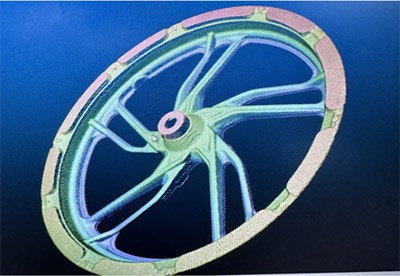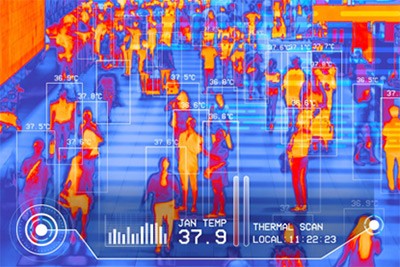Drive quality control with machine vision powered by artificial intelligence
Source: China Machine Vision Network
In today's fast-paced manufacturing environment, how to increase production capacity while maintaining high product quality is a challenge faced by many companies. Traditional visual inspection methods while effective in some applications are often time-consuming, labor-intensive, and prone to inconsistency. Artificial intelligence-driven machine vision is revolutionizing this critical function.
By integrating artificial intelligence with high-resolution imaging and smart software, manufacturers can now detect defects in real-time, reduce waste, and optimize production lines with unprecedented precision. These innovations are empowering companies across industries including automotive, electronics, food & beverage, pharmaceuticals, and semiconductors to enhance operational efficiency while strengthening their quality assurance systems.
Ⅰ. How does AI-driven machine vision revolutionize quality control
Machine vision has long played a vital role in product inspection and sorting within industrial environments. However, the integration of artificial intelligence particularly deep learning has significantly enhanced its capabilities. Traditional rule-based systems often struggle to handle product variability and complex defect patterns, requiring frequent manual adjustments. In contrast, AI-driven vision systems can analyze massive data, detect subtle anomalies, and adapt to new product types with minimal human intervention. This makes them particularly suitable for dynamic, multi-variety hybrid production lines where speed, precision, and adaptability are critical.
Unlike rule-based systems that require predefined standards and consistent defect types, AI-powered vision systems learn patterns from massive image datasets. They can detect anomalies and deviations even those of previously unseen types making them exceptionally efficient in dynamic manufacturing environments where product designs or materials undergo frequent changes.
1. Detecting microdefects invisible to the human eye
AI-powered visual systems can detect surface abnormalities, cracks, discoloration, or structural defects at microscopic levels with precision that often surpasses human eyes and traditional inspection tools. This level of accuracy is particularly valuable in industries like semiconductors, electronics, and medical devices, where even the tiniest imperfections could lead to product failures or safety hazards.
2. Learn and evolve with new data and changing product lines
Unlike traditional systems that require manual reprogramming for each product variant, AI-powered solutions continuously learn from new data sets. This enables manufacturers to implement design changes or launch new product lines without overhauling their inspection infrastructure. The result is a highly adaptive quality control process that evolves in sync with production demands.
3. Reduce false positives and missed detections
By leveraging deep learning algorithms, these systems can more accurately distinguish acceptable product variations from actual defects. This significantly reduces false positives (where qualified products are wrongly excluded) and missed detections (where defective products pass without being identified). Over time, this leads to improved product quality, fewer defects, and greater trust in automated inspection results. For industries like semiconductor manufacturing or medical device production where precision requires micrometer-level accuracy, AI-powered machine vision provides the consistency and speed needed for large-scale manufacturing.
4. Case study: Using 3D laser profiler to improve hub quality
In the automotive industry, wheel hub inspection is vital for ensuring vehicle safety, performance, and customer satisfaction. Traditional methods like 2D vision systems and contact measurements often fail to detect subtle yet critical defects such as micro-cracks, dents, or misalignment particularly on high-speed production lines. Manufacturers require fast, accurate, and non-contact inspection technologies that meet stringent OEM standards while minimizing downtime and costs.

A leading automotive OEM manufacturer addressed this challenge by integrating SinceVision's SR5320 3D laser profiler into its quality control process. Mounted on robotic arms, the device detects rotating wheels with a high-contrast 450nm blue laser that scans up to 67,000 contours per second. Its wide scanning range accommodates various wheel sizes, while its high-speed 3D imaging capability precisely identifies surface defects. The captured data enhances defect detection accuracy, optimizes production efficiency, and ensures compliance with stringent quality standards.
II. Improve efficiency with edge AI
In modern manufacturing and inspection systems, real-time processing of massive visual data is a critical requirement especially when decisions must be made within milliseconds. This is where edge AI (Edge AI) proves its value.
By deploying AI computing directly on production lines, edge-based machine vision systems reduce latency and eliminate the need to transmit image data to centralized servers or cloud platforms. This localized processing enables real-time decision-making and corrective actions, which is crucial in fast-paced environments requiring high production capacity and minimal downtime.
Edge AI also enables more scalable and flexible system architectures. Manufacturers can deploy smart systems that operate independently, without relying on network connectivity or centralized infrastructure, and can operate reliably even in remote or industrial environments.
III. Cincoze GM-1000 is used in thermal imaging
During the pandemic, edge AI played a pivotal role in public safety thermal imaging systems. A notable application was the implementation of Cincoze's technology in high-traffic areas like airports and hospitals. The GM-1000 industrial GPU-powered computers driving these systems enabled real-time body temperature screening, facial recognition, and mask detection all without relying on cloud processing.

The GM-1000 pairs with a thermal imaging camera to process infrared images at the edge using GPU-accelerated deep learning, enabling fast, non-contact monitoring. Its compact and rugged design supports harsh environments, while modular GPU support allows high-performance visual processing in tight spaces.
Originally developed for public safety, the application highlights how edge AI platforms like GM-1000 can be adapted for industrial tasks such as defect detection and predictive maintenance where speed, space and reliability are critical.
IV. Advanced imaging: 3D and multispectral vision
When AI-powered machine vision combines with advanced imaging technologies (such as 3D vision and hyperspectral analysis), its capabilities become significantly enhanced. These technologies extend detection capabilities beyond what the human eye ——and even traditional visual systems ——can perceive.
3D vision enhances detection capabilities by capturing surface contours, volume, and shape data that proves invaluable in applications like automated sorting, portion control, and packaging verification.In food processing environments, 3D imaging can be used in combination with hyperspectral data to detect deformation, monitor filling quantities or confirm correct product size thereby ensuring quality and consistency.
Hyperspectral imaging extends machine vision capabilities beyond the visible spectrum for analyzing a product's chemical composition, freshness and contamination levels. This is particularly useful in industries such as pharmaceuticals, agriculture and food processing.
V. ImpactVision uses hyperspectral imaging to declare war on food waste

A prime example of multispectral imaging applications is ImpactVision, a machine learning company that utilizes hyperspectral imaging technology to reduce food waste and enhance product quality. Their system is deployed in food processing plants, where Specim cameras installed above conveyor belts capture spectral data. The software then analyzes each product in real-time detecting freshness, foreign objects, and critical quality attributes without requiring destructive sampling.